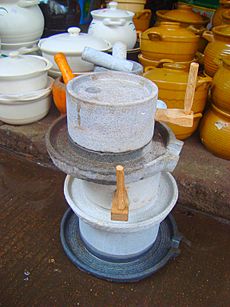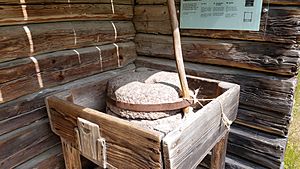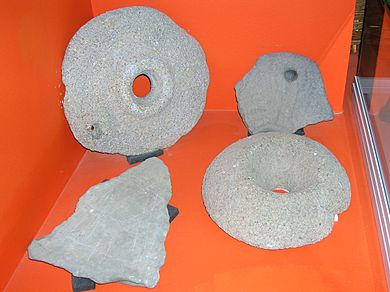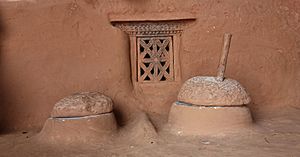Quern-stone facts for kids
Quern-stones are special stone tools. People use them in pairs to grind many different materials by hand. The bottom stone stays still. The top stone moves.
Early quern-stones had a lower stone shaped like a saddle. The upper stone was called a muller or handstone. People moved this upper stone back and forth. Later querns were called rotary querns. These spun in a circle. Rotary querns have a central hole called the eye. A dip on the top surface is called the hopper. A handle slot held a handle. This handle helped turn the stone. Quern-stones were first used in the Neolithic era. This was a very long time ago. People used them to grind grains into flour.
Contents
What Are Quern-Stones Used For?
Quern-stones have been used by many different groups of people. They are found all over the world.
How Quern-Stones Are Designed
The top stones of querns were usually curved inward. The bottom stones were curved outward. Quern-stones often have grooves on their grinding surfaces. These grooves helped the flour move out. Sometimes, a piece of wood called a millrind was used. It helped keep the grain centered while grinding.
The top stone sometimes had a cup-shaped area around the hopper hole. This area had a raised edge. Most handstones have a hole for a handle on top. Some quern-stones have a slot for a handle. This means a piece of wood was placed sideways. It stuck out so the user could turn the stone. Some top quern-stones have two or three holes for the turning rod. This might have helped reduce wear and tear.
Grinding Grain with Querns
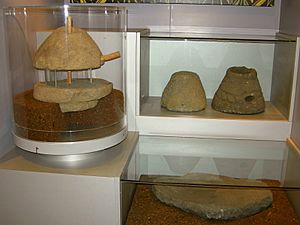
One of the most important uses for quern-stones was grinding grain. This made flour for bread-making. Later, bigger millstones took their place. These were used in mills powered by water or wind. Animals also helped turn these larger mills.
However, in many parts of the world, people still make and use quern-stones. They have only been replaced in the last 100 years in some areas. Grinding stones were used in Europe at least 30,000 years ago. They helped process plant foods and make flour.
In early Maya civilizations, people had a special way to prepare corn. They boiled hard corn kernels in water with lime. This made "nixtamal." Then, they ground it with a handstone on a quern. This made dough for flat cakes.
Quern-stones were used in China about 10,000 years ago. They ground wheat into flour. Making flour by hand took many hours. Saddle querns were known in China during the Neolithic Age. Rotary stone mills appeared later. A very old quern, from 23,000 BCE, was found in China in 2007.
Grinding Other Materials
Besides grain, quern-stones ground many other things. These included nuts, seeds, fruits, and vegetables. They also ground herbs, spices, and even meat. People used them for bark, pigments, and clay too.
One study found traces of arsenic and bismuth on some querns. These elements were not in the original rocks. This suggests the querns were used for medicines or cosmetics. They might have even been used to make metal alloys.
Querns were also widely used to grind metal ores. After mining, the ore was ground. This helped separate the fine metal particles. Then, these particles could be washed before melting. They were very important in ancient gold mining.
In Shetland, people used special snuff-querns. They ground tobacco leaves into fine powder. This powder was then inhaled. These querns had an upper and lower stone. They were held together by a metal pin. The user filled the quern with dried tobacco. Then, they turned the top stone with a handle. The friction ground the leaves into powder.
Surprising Uses of Quern-Stones
Some surprising uses of quern-stones have been recorded. For example, some North American tribes used them in gambling games. They bounced split canes off a quern.
How Quern-Stones Are Made
The best stones for querns are igneous rocks like basalt. These rocks have naturally rough surfaces. But their grains do not easily break off. This means the ground material does not become gritty. However, these rocks are not always available. So, quern-stones have been made from many other rocks. These include sandstone, quartzite, and limestone.
In Scotland, research shows that different regions had their own styles. In the southern Levant, basalt quern-stones were preferred. They were carried long distances. This suggests they were also a status symbol, not just tools.

How Quern-Stones Changed Over Time
Knocking stones were used for small amounts of grain. But the earliest querns were saddle and trough querns. The oldest quern found so far is from about 9,000 BCE. It was found in Abu Hureyra, Syria. Later, the rotary quern was developed. It came in several forms.
Saddle Quern
The saddle quern gets its name from its shape. It looks like a saddle. This shape is made by rocking the muller back and forth. Saddle querns are the oldest and most common type. They were replaced by the more efficient rotary quern around 500-400 BC.
The handstones for saddle querns are usually like a rolling pin. They are used with both hands. Or they can be half-sphere shaped and used with one hand. This motion crushes the grain, it does not grind it finely. It works better for malted grain. It is hard to make fine flour from unmalted grain with a saddle quern.
Rotary Quern
As the name suggests, the rotary quern uses circular motions. Both the top and bottom stones are usually round. The handstone of a rotary quern is much heavier. This weight helps grind unmalted grain into flour. Sometimes, the grinding surfaces fit together. The top stone is slightly curved inward, and the bottom one outward.
Beehive Quern
In this type, the top stone is shaped like a hemisphere or a bun. It has a central cone-shaped hopper for grain. The grain falls down a hole to the grinding surface. A pivot holds it in place in a hole in the bottom stone. The top stone also has a deep slot for a wooden peg. This peg was the handle used to spin the stone.
This was the first type of rotary quern in the British Isles. It arrived in Britain during the middle Iron Age (around 400–300 BC). It then spread to northern Ireland, probably from Scotland.
Disc Quern
The disc rotary quern has larger, flatter, and more disc-shaped stones. The bottom stone had a hole all the way through. The long handle spun in a shallow hole on the top surface of the upper stone. These querns may have started in Spain 2,500 years ago. They seem to have arrived in Scotland around 200 BC. People who built defensive homes called brochs brought them. This Iron Age type looks a lot like the Highland quern still used in later times.
Thomas Pennant described using a hand quern in Scotland in 1800:
The quern has two round stones, usually grit or granite. They are about twenty inches wide. The bottom stone has a wooden peg. The top stone balances on this peg. It just touches the bottom stone. A piece of wood in a large hole in the top stone helps balance it. There is room around this wood to feed grain into the mill. It balances so well that a small push makes it spin many times when empty. When grinding, two women sit on the ground with the quern between them. One feeds it, while the other turns it. They take turns and sing Celtic songs.
Miniature Quern
A new type of quern has been found. These are smaller than 200 mm (about 8 inches) across. They range from rough to carefully made. They often have vertical handle holes. In the past, people thought they were weights. But they look like full-sized quern-stones. They also show signs of wear from grinding. This means they were used for small amounts of seeds, minerals, or herbs. It is unlikely they were just toys.
Other Types of Quern-Stones
Other quern-stones include hopper-rubbers and Pompeian mills. The Romans used both. Larger rotary mills were often turned by a donkey or horse. An extension arm of wood attached to the top stone helped them.
Querns that used crank-and-connecting rods were used in the Western Han Dynasty in China.
Laws About Using Querns
In Scotland, tenants had to pay to use the baron's mill. Early mill leases gave the miller the right to destroy quern-stones. This was if people used them instead of the baron's mill. This rule was called thirlage.
The rules of thirlage eventually ended. Thirlage in Scotland was officially abolished on November 28, 2004. Similar rules existed in England too.
Decorations on Quern-Stones
Some handstones have extra carvings. It can be hard to tell if these are just decorations or have a purpose. The designs look good when the handstone spins. Quern-stones turn seeds into flour. This might have felt like magic. It could have made these household objects special and important.
Three beehive querns found in Ireland have special La Tène designs. Examples from England and Wales also have them. Many horizontal slot-handled quern-stones have decorations. These usually circle the hopper or the handle slot. One type has an uneven pattern of cup marks around the hopper.
A quern was found at Dunadd in Scotland. It has a cross carved into the top stone. This cross comes from Roman and Byzantine designs from the 400s and 500s. This quern was very well made. This shows its value and importance. The cross probably protected the corn and flour from evil. This could include fungal rust.
Many legends give special powers to mill-stones. Several have been found reused in burial sites. They were used to build tombs or as gravestones. Quern-stones are linked to burial. This might be because they make bread, which is a basic food for life. A broken or unused quern could symbolize death. In Clonmacnoise, Ireland, a quern stone was found. It was made into a tombstone. It was decorated and had the name Sechnasach, who died in 928 AD, carved on it. A large quern was found on the Lough Scur crannog in Ireland.
The Amazing Mauchline Quern
In the 800s, a Welsh monk named Nennius wrote a history of Britain. He listed thirteen wonders of Britain. One was the amazing 'Mauchline Quern'. It ground constantly, except on Sundays. People could hear it working underground. A local place name, 'Auchenbrain', might be named after it. This name means 'field of the quern' in Gaelic.
Other Grinding Tools
- Knocking stone
- Jato: A type of rotary quern-stone used in the Himalayan region.
- Batu giling (Malay)
- Manos and metate
- Millstone
See also
 In Spanish: Molino de mano para niños
In Spanish: Molino de mano para niños



